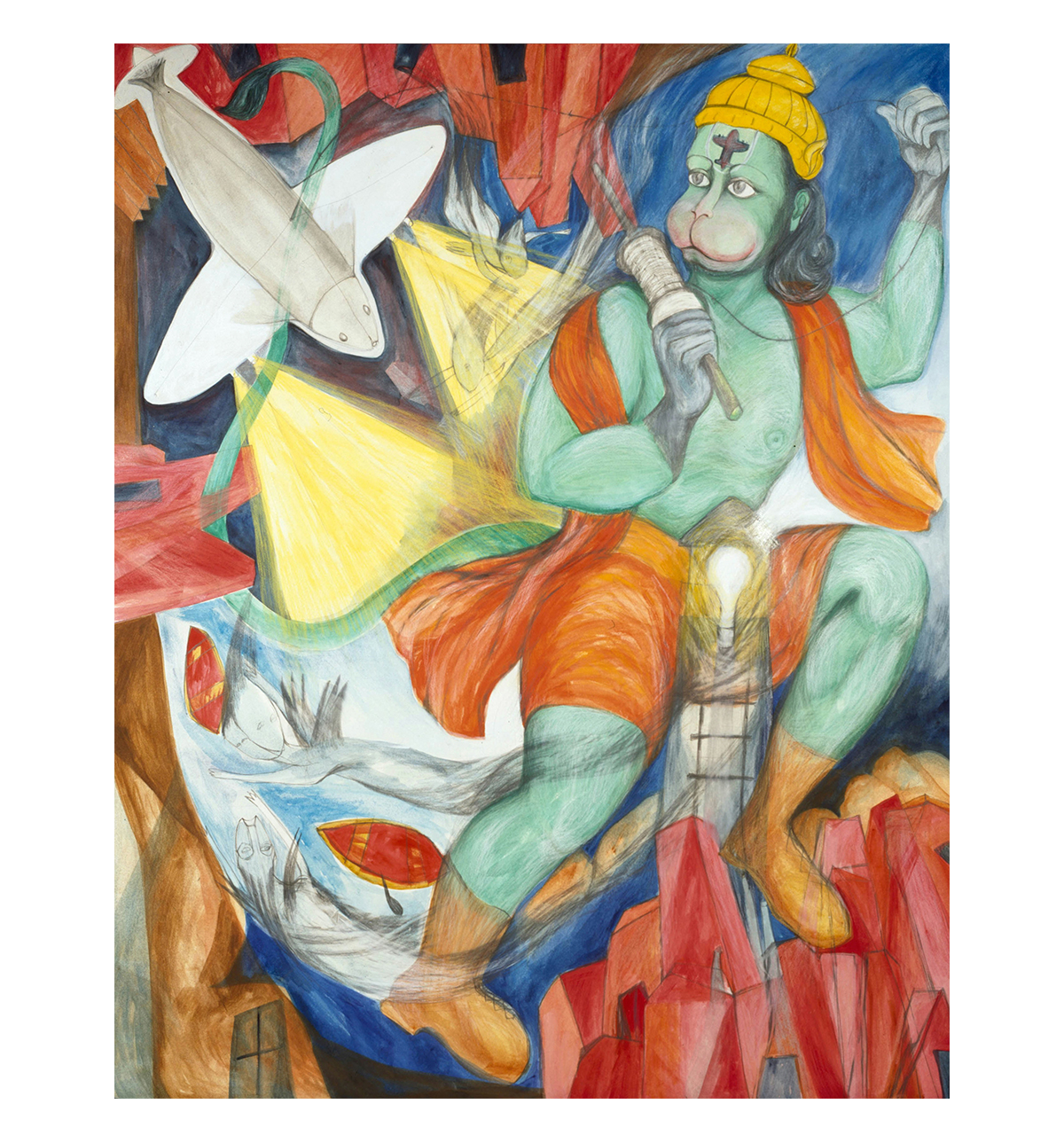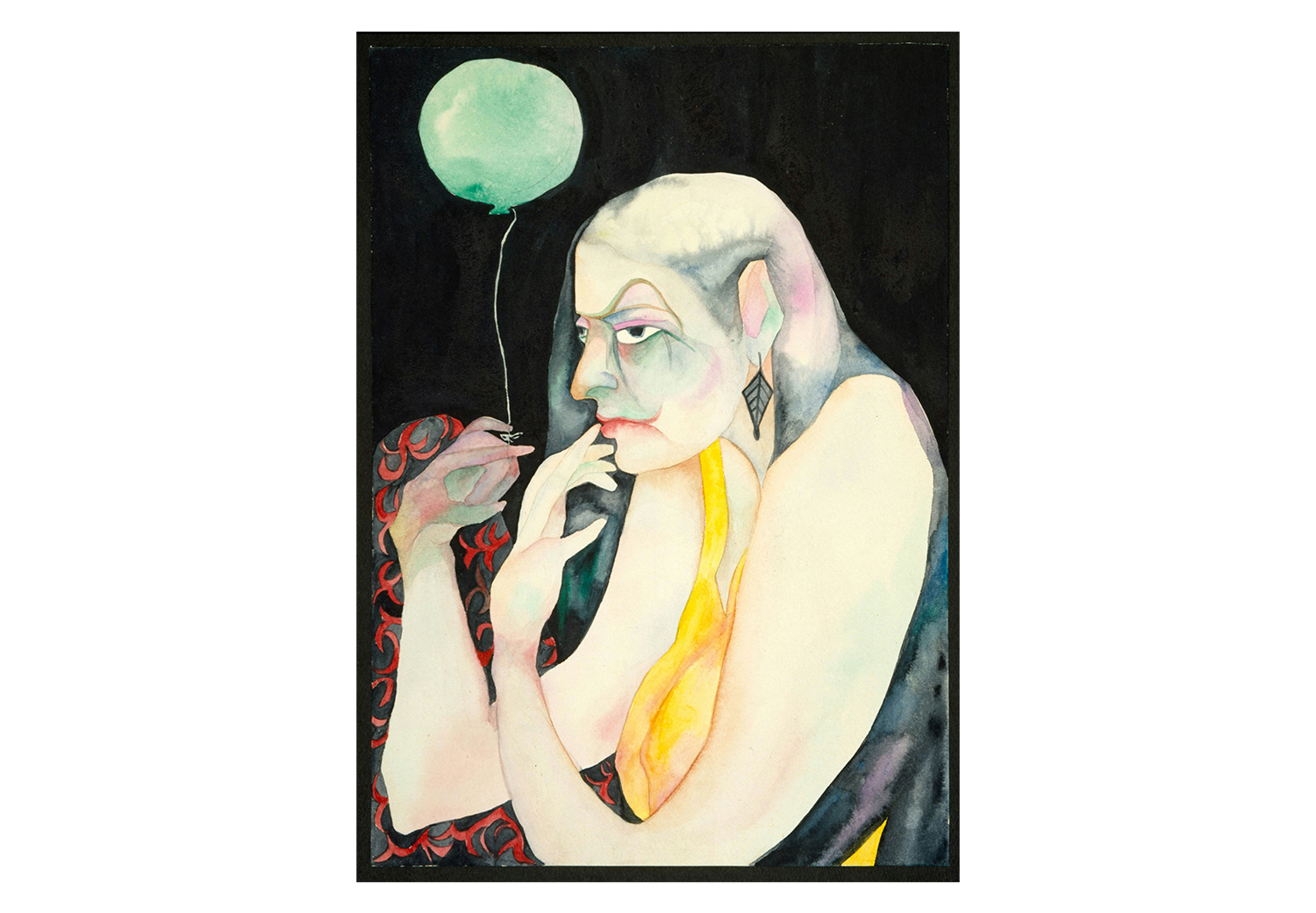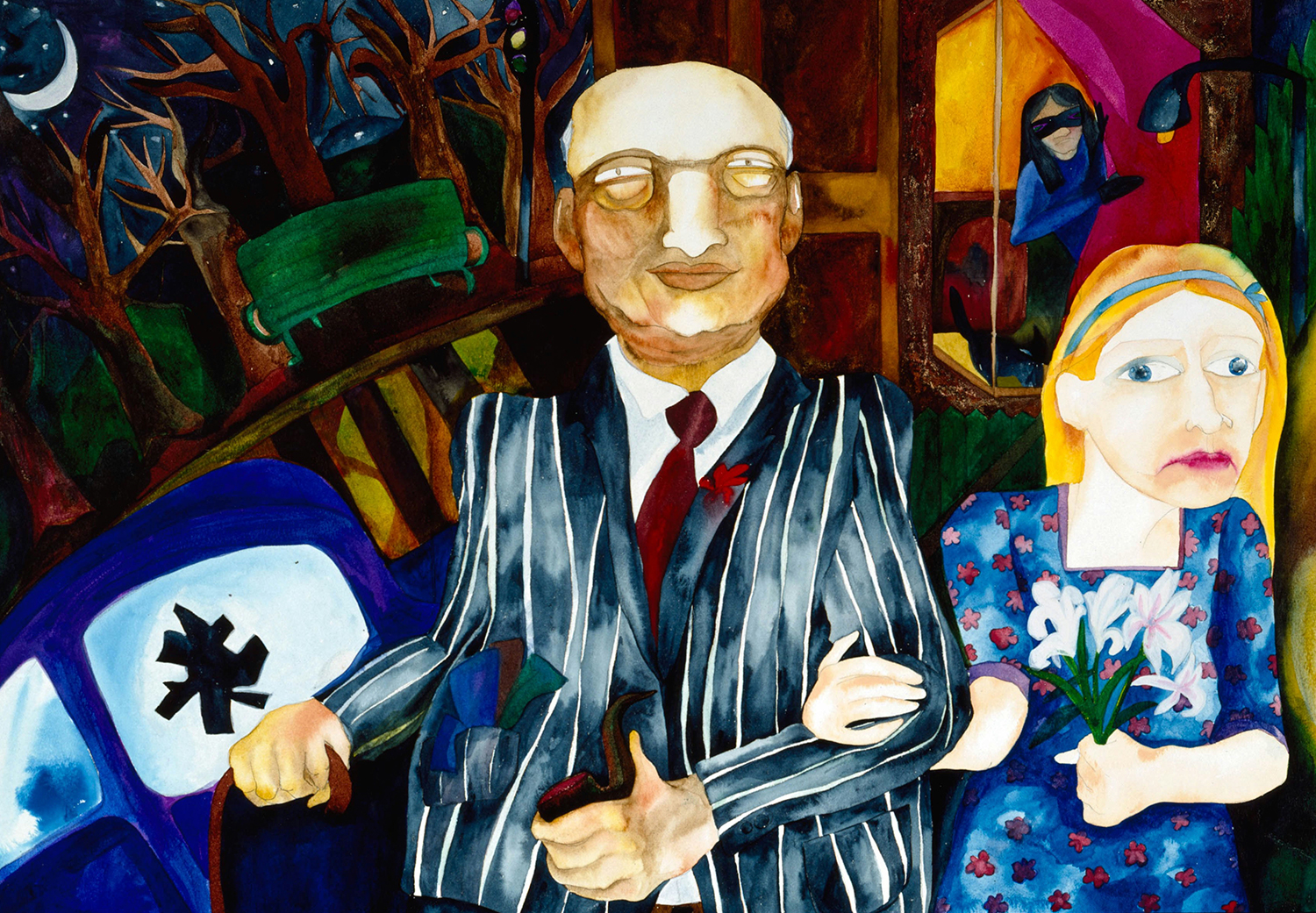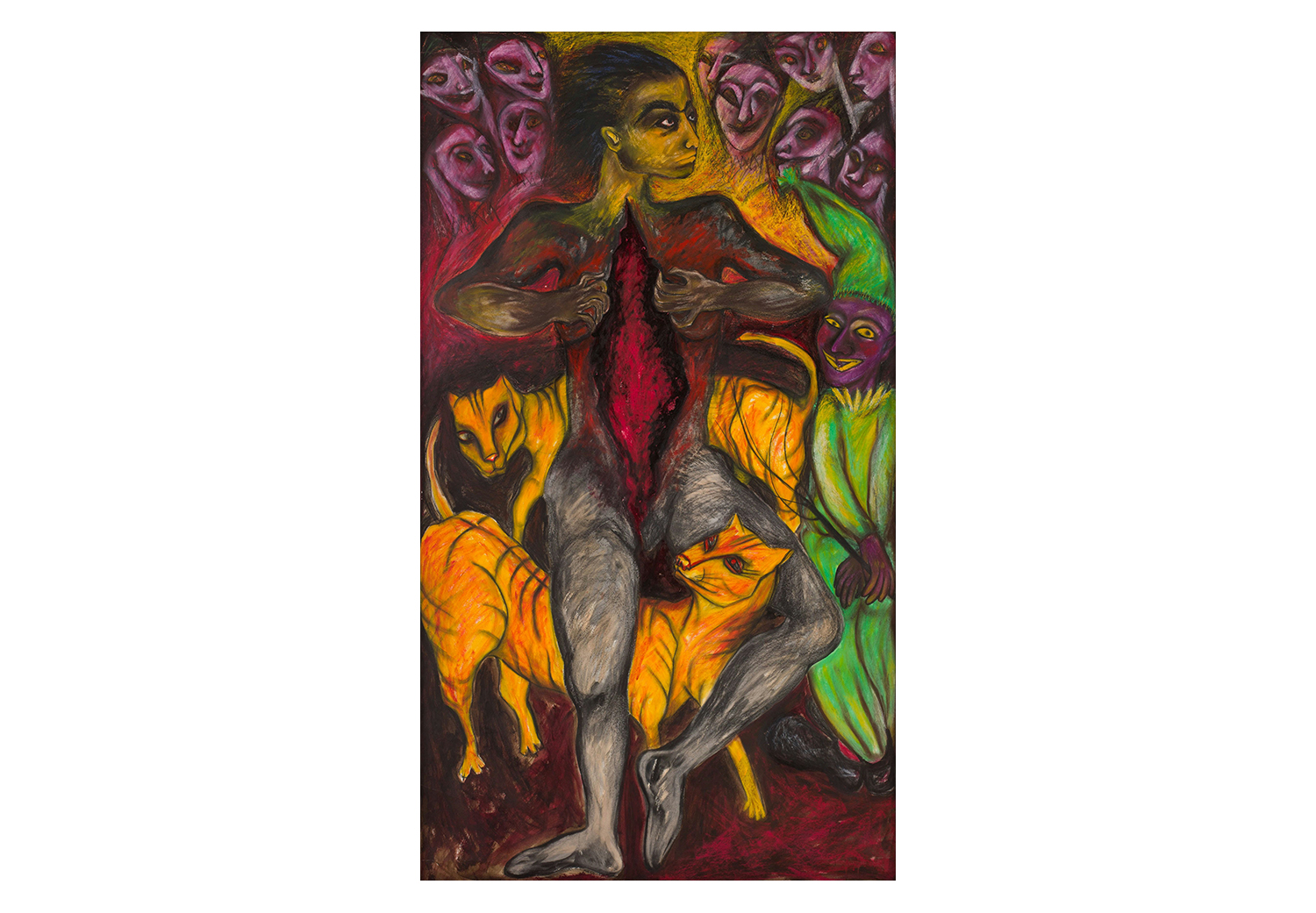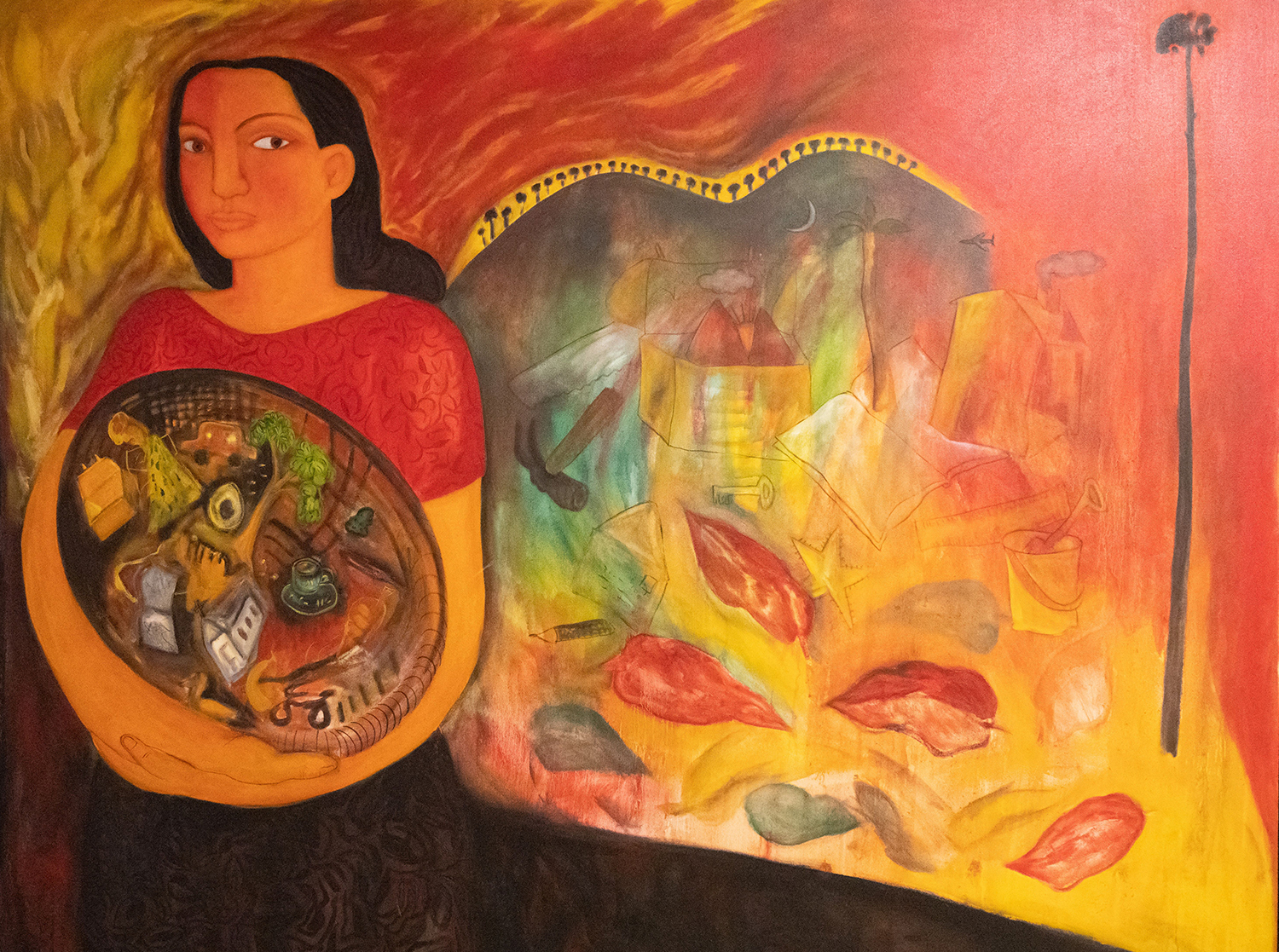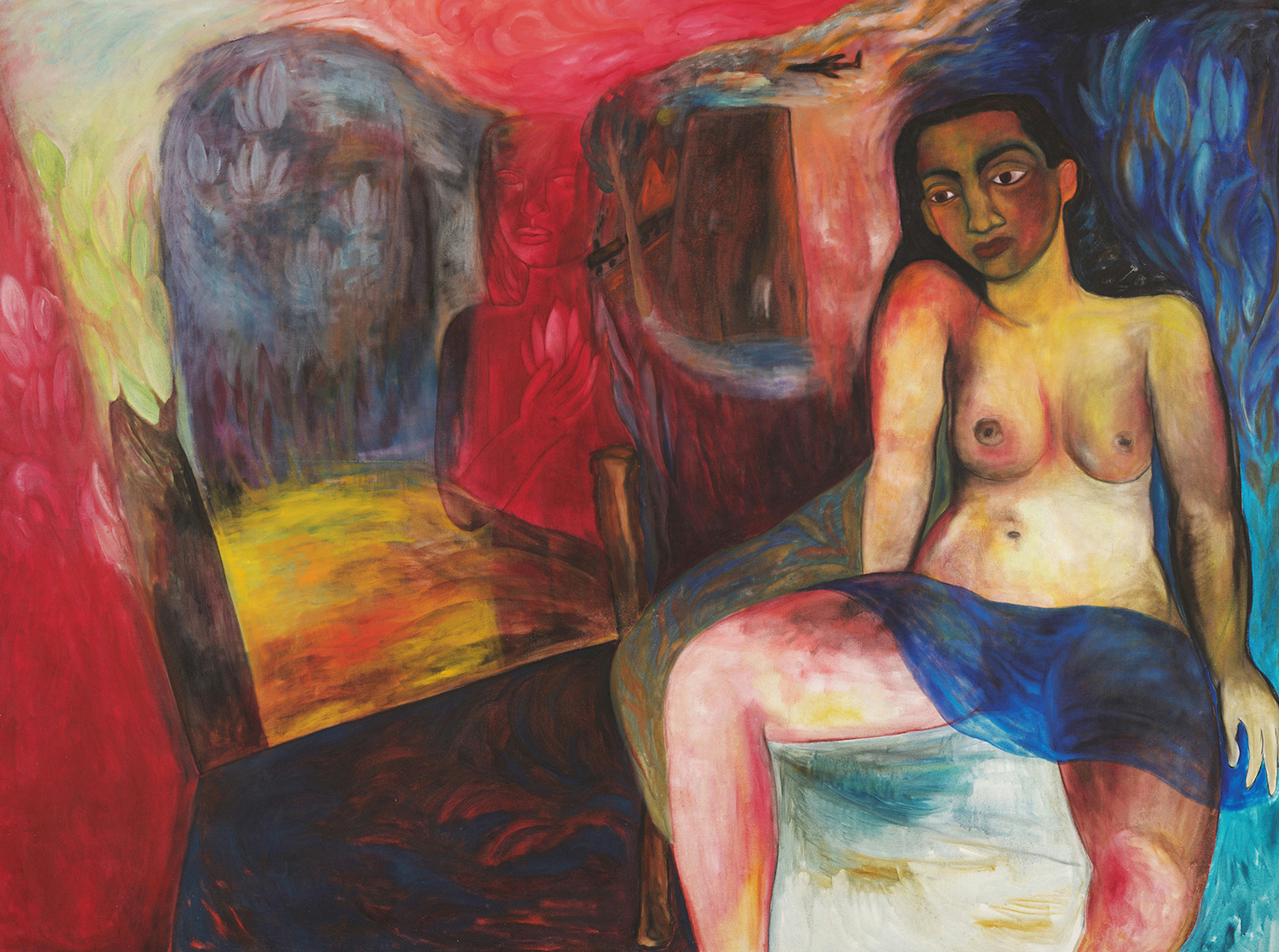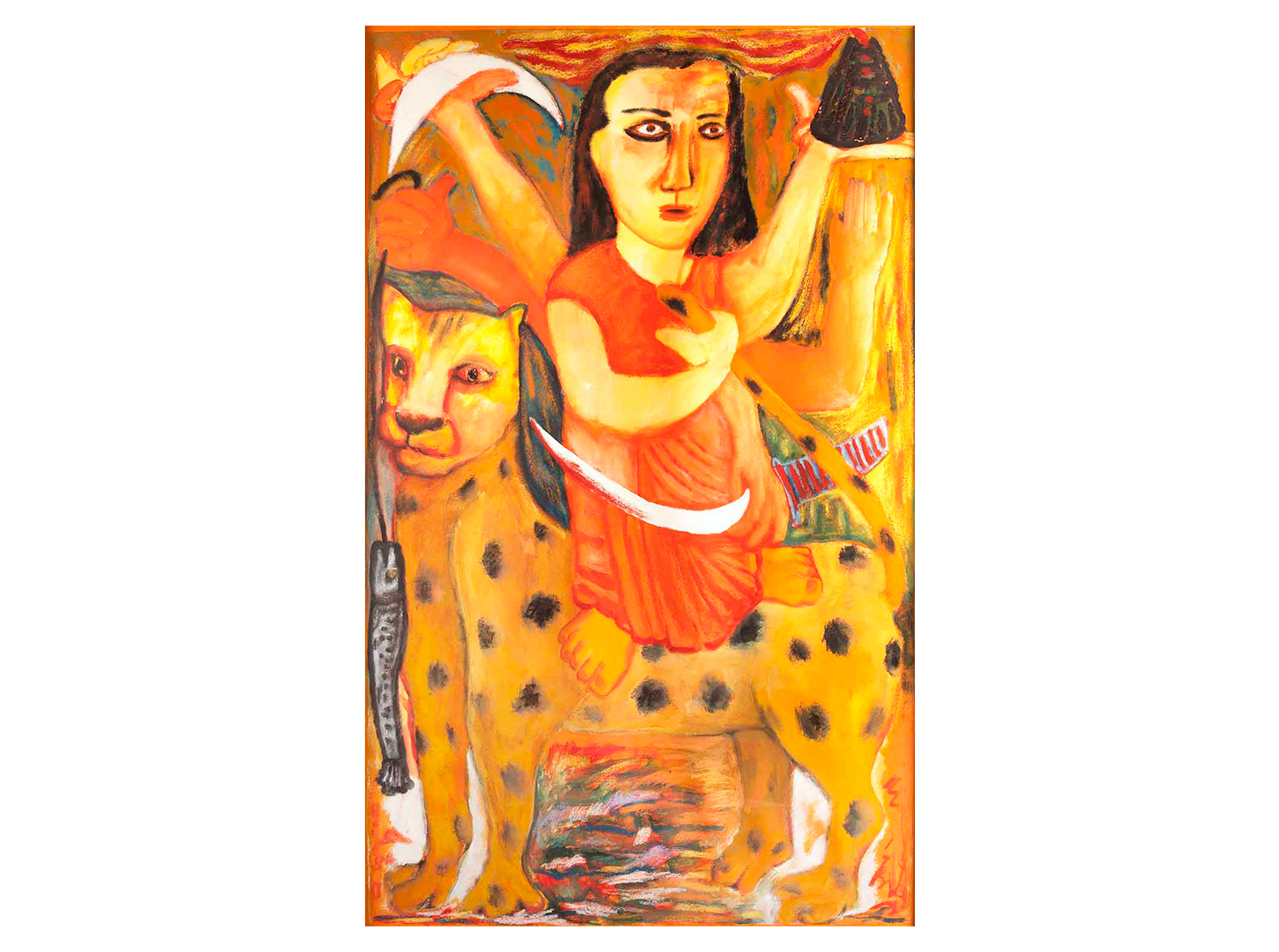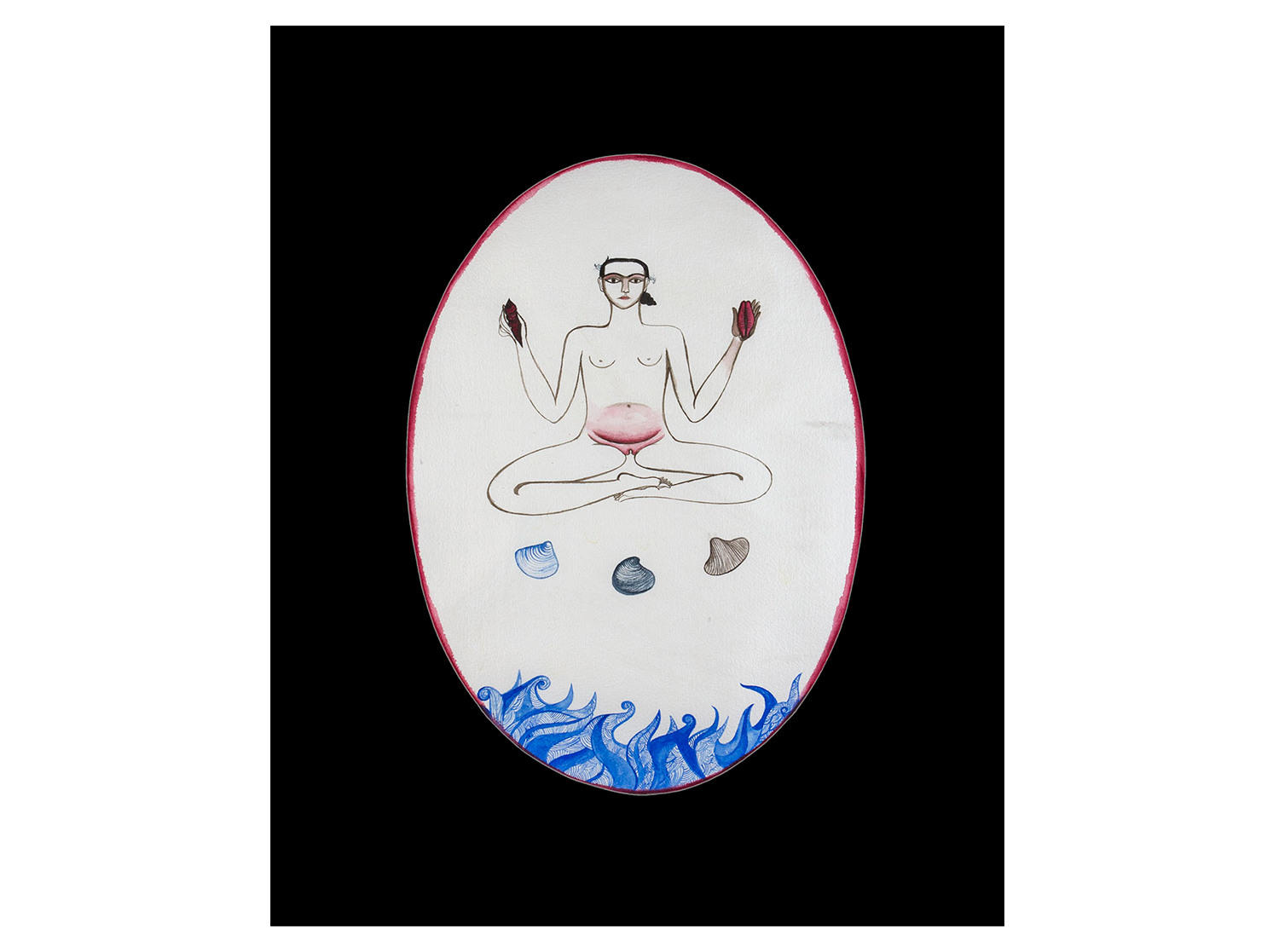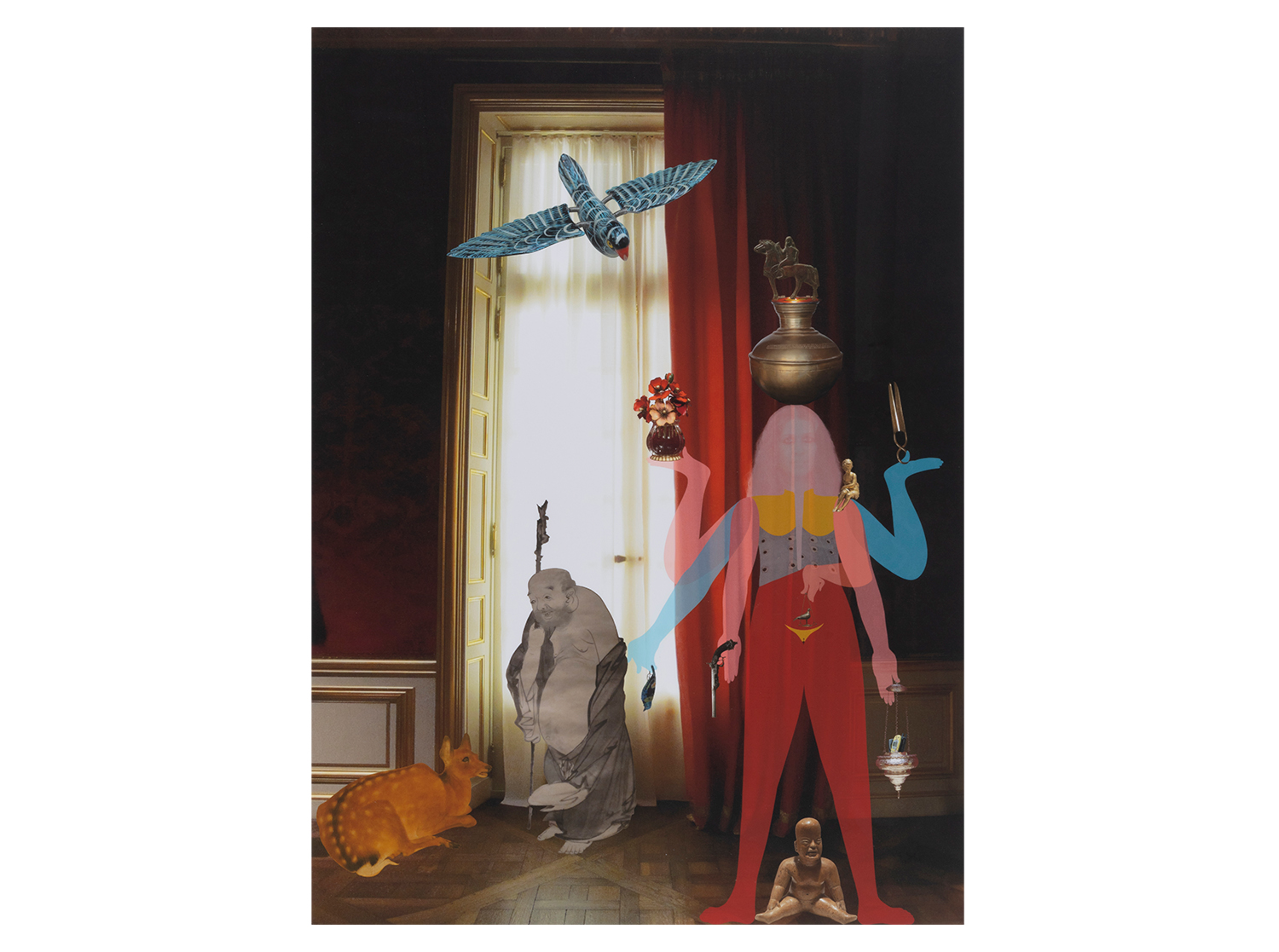ARTICLE
Rekha Rodwittiya (b. 1958)
A contemporary Indian artist, curator and teacher, Rekha Rodwittiya is known for her figurative paintings and self-portraits that focus on the politics around the female body, often averting the male gaze by depicting almost androgynous forms. Rendered largely in watercolour, acrylic and oil, on paper as well as canvas, her works often employ large, bold shapes and clean lines in an almost graphic style. Rodwittiya draws on South Asian iconography, Western aesthetic conventions and personal experience to explore socio-political issues from a feminist perspective, creating a densely-layered visual vocabulary.
Born in Bangalore (now Bengaluru) in 1958, Rodwittiya developed a keen interest in the arts at a young age. Growing up in a non-patriarchal, urban middle class family where she was allowed freedom of thought and experience, she was able to pursue this interest from early childhood onwards. Her family travelled extensively, living in various cities before moving to Baroda (now Vadodara) in 1967. She enrolled in the undergraduate painting programme at the Faculty of Fine Arts, MS University, Baroda in 1976, where she studied primarily under the tutelage of artists Jyoti Bhatt and Nasreen Mohamedi. She also learnt photography from Bhatt, and sold her photographs through student-organised exhibitions or through friends within her circle. This allowed her to be financially independent and offered the stability she sought as a single mother during her student days. In 1982, she was awarded an Inlaks scholarship to pursue a master’s degree in painting at the Royal College of Art, London; she also studied film and video for a brief period while in London. After returning to India, she settled in Baroda where she set up the Collective Studio in 1984, which offers a space for young artists to develop their practice. She has developed and run this initiative with her partner, the artist Surendran Nair, whom she met in 1985. In 1990, Rodwittiya was awarded a fellowship by the Rockefeller Foundation’s Asian Cultural Council, which enabled her to work in New York City, USA for six months. In 1991, she delivered a series of lectures on Indian art in France and Italy, at the invitation of the Ecole des Beaux Arts, Grenoble, and Castello de Rivoli, Torino.
During the seventies, Rodwittiya experimented with figurative art like most other artists teaching or studying in Baroda at the time. She strengthened her figurative and narrative expression while studying at the Royal College of Art, where she produced close to two hundred watercolour paintings in two years. Her works from this period communicate politics of power, violence and gender through the use of cartoon-like figures and a tableau format. For example, in The Ornate Chair Still Beckons (mid-1980s) she depicts a male figure sitting on a throne-like chair, maintaining steady eye contact with an animal-like figure who inflicts violence on a female figure situated on the extreme right of the painting. London was rife with protests against the then prime minister Margaret Thatcher, and Rodwittiya felt drawn to issues centred around women. It was in London that she was exposed to a lot more literature and culture that focussed on women’s issues, compared with the Marxist ideology prevalent in Baroda circles. Away from India, she was able to understand more clearly, and in turn convey through her paintings, the patriarchy prevalent in the country.
In the 1990s, Rodwittiya’s paintings showed energetic, powerful figures painted in vibrant colours against dramatic backdrops. The women in these paintings and later series often stand as protectors of society against backdrops of destruction, violence and degradation, as in At the Graveyard of My Childhood from 1994. Here, a solitary female figure stands holding a basket filled with large and small objects — including a teacup, a bicycle, a car, buildings and trees — almost as if cradling society. The fiery backdrop behind her contains scattered overlapping motifs such as leaves, books, tools, houses and an aeroplane, with a landscape in silhouette appearing above them. She showcases her women as vulnerable, yet strong and resilient characters, who survive despite social and patriarchal injustices. The colour red is predominantly used in her paintings of this period, due to its symbolism in South Asian rituals as a colour of violence, passion and feminine connotations, such as fertility.
By the 2000s, Rodwittiya modified her language and reduced the number of elements in the negative space of her paintings, bringing more intricacy to the central figure. In works from this period, she depicts full-frontal female figures against a solid coloured background, who confront the viewer with their authoritative gaze. In works such as Once Upon a Time (2005–06), she includes elements that are both autobiographical and metaphorical. Motifs such as cats, paint brushes, diyas or sacred lamps and bowls, with their particular significance to the artist, become part of a rich personal tapestry interwoven with broader South Asian iconography.
Recognisable elements from the traditional imagery that populates her work include the archetypal female protagonist nayika, Hindu deities in yoga poses, lotuses, the mythological bull Nandi and the Himalayan mountain goat markhor. Many of these can be seen across her work, particularly in the Love Done Right Can Change the World series from 2015. Her female figures also sometimes carry guns, long swords and knives in paintings from the 2010s. This is seen in the Matters of the Heart series (c. 2014), where Rodwittiya combines watercolour painting with photomontages to make self-portraits and images of warrior-like women often posed as powerful guardian figures from traditional Indian art. The photomontages are composed within the outlines of the central figure, such that they appear to be draping as well as contained within the figure. They comprise photographs collected on her travels around the world — like the many personal objects that recur in her work — showing monuments, natural landscapes and an image of the Mexican artist Frida Kahlo.
In addition to practising as an artist, Rodwittiya is also a curator and teacher, primarily at the Collective Studio, Baroda. The Studio is modelled on the ancient guru-shishya or ‘teacher-student’ tradition, with Rodwittiya and Nair offering personalised teaching, financial assistance and boarding to young artists. Rodwittiya has curated shows of the resident artists at the Studio, as well as of other artists including Jyoti Bhatt, Manisha Gera Baswani, and Nair. She has also curated exhibitions on Nair and Bhatt at Cymroza Art Gallery and Sakshi Gallery in Mumbai.
Rodwittiya has exhibited widely in India and internationally, with notable recent examples including Rituals of Memory at Aicon Gallery in 2016 and Rekha@Sixty: Transient Worlds of Belonging at Sakshi Gallery in 2018. Her works are part of private and public collections, including the Peabody Essex Museum, Massachusetts and the Museum of Art & Photography (MAP), Bengaluru.
At the time of writing, Rodwittiya lives and works in Vadodara.
Bibliography
Aicon Gallery. “Rekha Rodwittiya: The Rituals of Memory.” Exhibitions. February 2016. Accessed July 17, 2023. https://www.aicon.art/exhibitions/rekha-rodwittiya.
Milford-Lutzker, Mary-Ann. “Five Artists from India: Gogi Saroj Pal, Rekha Rodwittiya, Navjot, Anupam Sud, Rummana Hussain.” Woman’s Art Journal 23, no. 2 (Autumn 2002 – Winter 2003): 21–27. https://www.jstor.org/stable/1358704.
Rodwittiya, Rekha. “Second Skin: In Conversation with my Mother’s Daughter.” Critical Collective. First published Sakshi Gallery, Mumbai: 2007. Accessed July 14, 2023. https://criticalcollective.in/SearchResult.aspx?search=rekha%20rodwittiya.
Rodwittiya, Rekha, and Daniel Herwitz. The Rituals of Memory: Personal Folklores & Other Tales. New York: Aicon Gallery, 2016.
Sawhney, Kamini, Arnika Ahldag, Vaishnavi Kambadur, Arshad Hakim, Riya Kumar, eds. Visible/Invisible: Representation of Women in Art through the MAP Collection. Bengaluru: Museum of Art & Photography, 2022.
Srinivasan, Sanjana. “Rekha Rodwittiya: Abundant, Verdant, Chilling, and Surreal.” Degree Critical (Fall 2018). January 18, 2019. https://artwriting.sva.edu/journal/post/rekha-rodwittiya-abundant-verdant-chilling-surreal.
Space 118. “The Collective Studio Baroda.” Accessed July 14, 2023. https://www.space118.com/mapping-residencies/the-collective-studio/.
Vasvani, Bansie. “Talismanic and Tenacious Goddesses that Resist Femininity.” Hyperallergic, February 18, 2016. Accessed July 17, 2023. https://hyperallergic.com/276736/talismanic-and-tenacious-goddesses-that-resist-femininity/.




